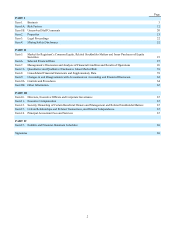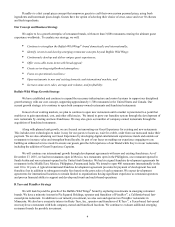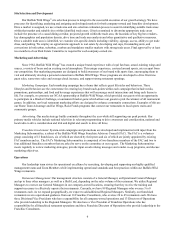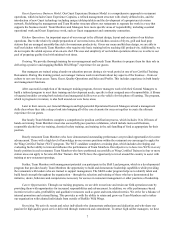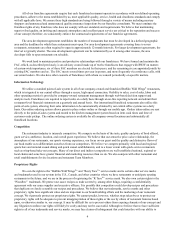Buffalo Wild Wings 2015 Annual Report Download - page 12
Download and view the complete annual report
Please find page 12 of the 2015 Buffalo Wild Wings annual report below. You can navigate through the pages in the report by either clicking on the pages listed below, or by using the keyword search tool below to find specific information within the annual report.12
Wells Fargo Home Mortgage as Director of Human Resources. Earlier in his career Mr. Block worked in the Human Resources
field for Ecolab and a subsidiary of Sony Corporation of America.
Emily C. Decker, 36, has served as our Senior Vice President, General Counsel and Secretary since April 2014. She
served as our Vice President, General Counsel and Secretary from January 2011 to April 2014 and as our Franchise Attorney
from August 2007 until January 2011. From September 2004 to July 2007, Ms. Decker was an Associate at Briggs and Morgan,
P.A., which provides legal services to us from time to time.
ITEM 1A. RISK FACTORS
This Form 10-K, including the discussions contained in Items 1 and 7, contains various “forward-looking statements”
within the meaning of Section 27A of the Securities Act of 1933, as amended, and Section 21E of the Securities Exchange Act
of 1934, as amended. Forward-looking statements are based on current expectations or beliefs concerning future events. Such
statements can be identified by the use of terminology such as “anticipate,” “believe,” “estimate,” “expect,” “intend,” “may,”
“could,” “possible,” “plan,” “project,” “will,” “forecast” and similar words or expressions. Our forward-looking statements
generally relate to our growth strategy, financial results, sales efforts, franchise expectations, restaurant openings and related
expense, and cash requirements. Although we believe there is a reasonable basis for the forward-looking statements, our actual
results could be materially different. While it is not possible to foresee all of the factors that may cause actual results to differ
from our forward-looking statements, such factors include, among others, the risk factors that follow. Investors are cautioned
that all forward-looking statements involve risks and uncertainties and speak only as of the date on which they are made, and
we do not undertake any obligation to update any forward-looking statement.
Unfavorable publicity could harm our business.
Multi-unit restaurant businesses such as ours can be adversely affected by publicity resulting from complaints or
litigation or general publicity regarding poor food quality, food-borne illness, personal injury, food tampering, team member
relations, adverse health effects of consumption of various food products or high-calorie foods (including obesity), or other
concerns. Negative publicity from traditional or digital media, or from on-line social network postings may also result from
actual or alleged incidents or events taking place in our restaurants. Regardless of whether the allegations or complaints are
valid, unfavorable publicity relating to a number of our restaurants, or only to a single restaurant, could adversely affect public
perception of the entire brand. Adverse publicity and its effect on overall consumer perceptions of food safety, or our failure to
respond effectively to adverse publicity, could have a material adverse effect on our business.
Fluctuations in chicken wing prices could impact our operating income.
Chicken wings are a primary food product used by our Buffalo Wild Wings® restaurants. We work to counteract the
effect of the volatility of chicken wing prices, which can significantly change our cost of sales and cash flow, with the
introduction of new menu items, effective marketing promotions, focused efforts on food costs and waste, and menu price
increases. During 2013, we began selling our wings by portion, providing our guests a more consistent amount of chicken in
their orders, and decreasing the impact of yield fluctuations on our cost of sales. We also explore purchasing strategies to
reduce the severity of cost increases and fluctuations. The price we pay for chicken wings is determined based on the average
of the previous month’s wing market plus mark-up for processing and distribution. If the monthly average exceeds the upper
threshold or falls below the lower threshold set in the contract, we split the impact with our suppliers, reducing our risk related
to wing price fluctuations. If a satisfactory long-term pricing agreement for chicken wings were to arise, we would consider
locking in prices to reduce our price volatility. Chicken wing prices in 2015 averaged 18.1% higher than 2014 as the average
price per pound increased to $1.83 in 2015 from $1.55 in 2014. If there is a significant rise in the price of chicken wings, and
we are unable to successfully adjust menu prices or menu mix or otherwise make operational adjustments to account for the
higher wing prices, our operating results could be adversely affected. For example, chicken wings accounted for approximately
25%, 23%, and 25% of our cost of sales in 2015, 2014, and 2013, respectively, with an annual average price per pound of
$1.83, $1.55, and $1.76, respectively. A 10% increase in the chicken wing costs for 2015 would have increased cost of sales by
approximately $12.9 million. Additional information related to chicken wing prices is included in Item 7 under “Results of
Operations.”


